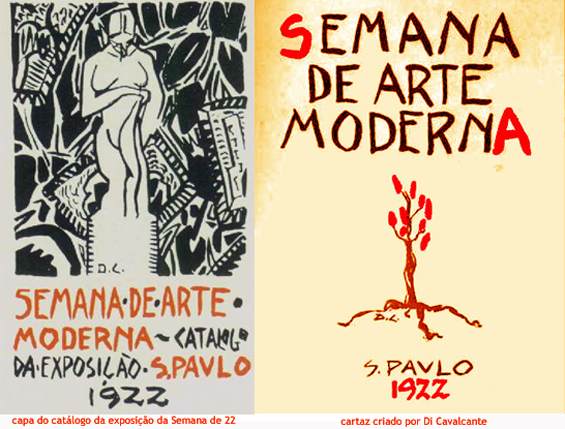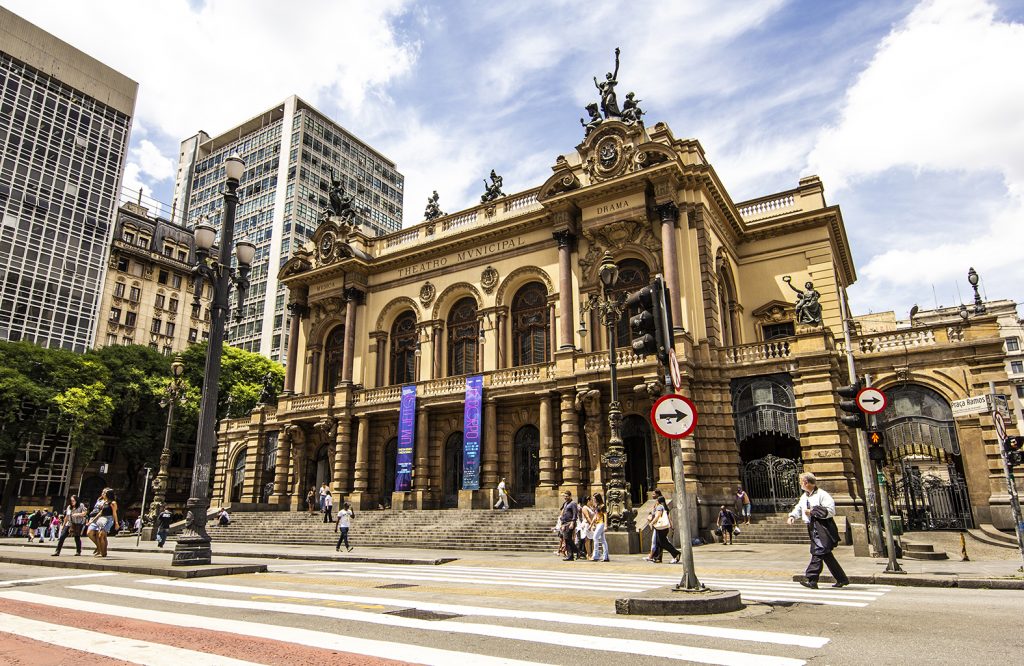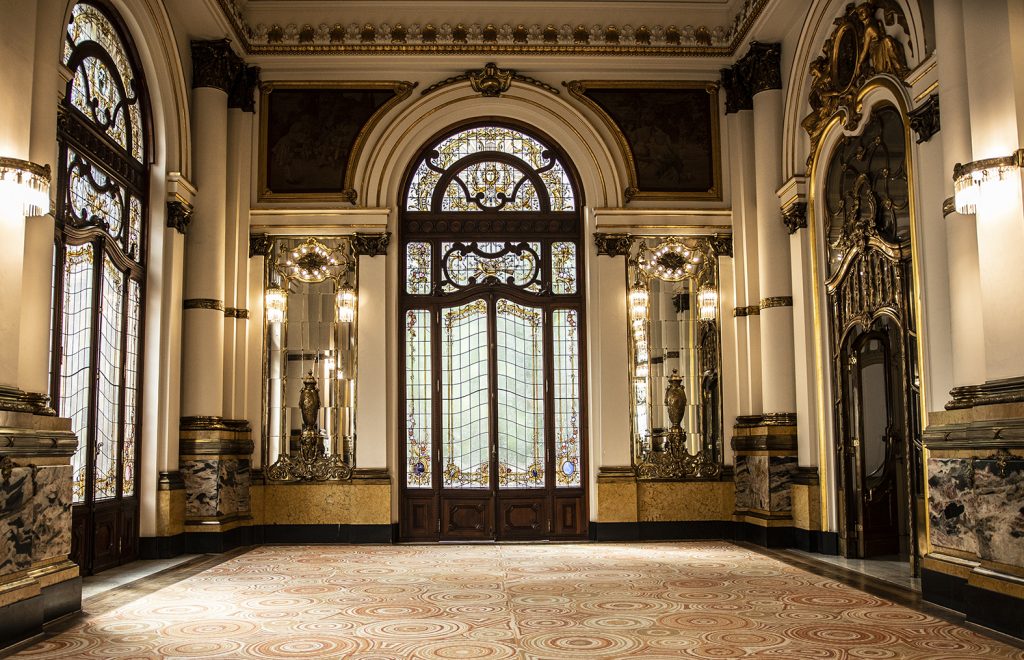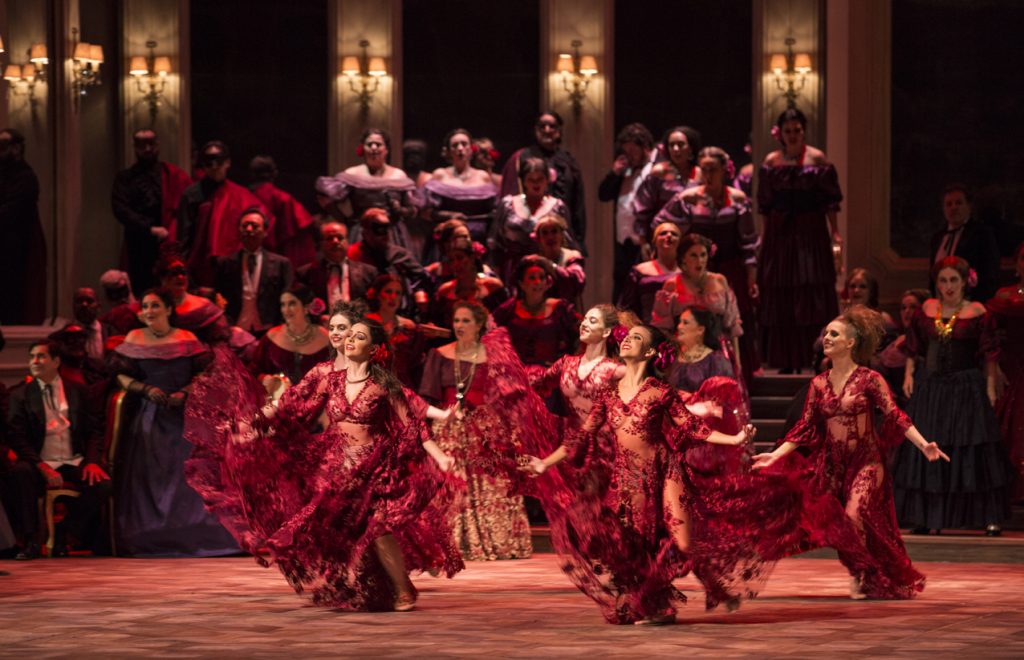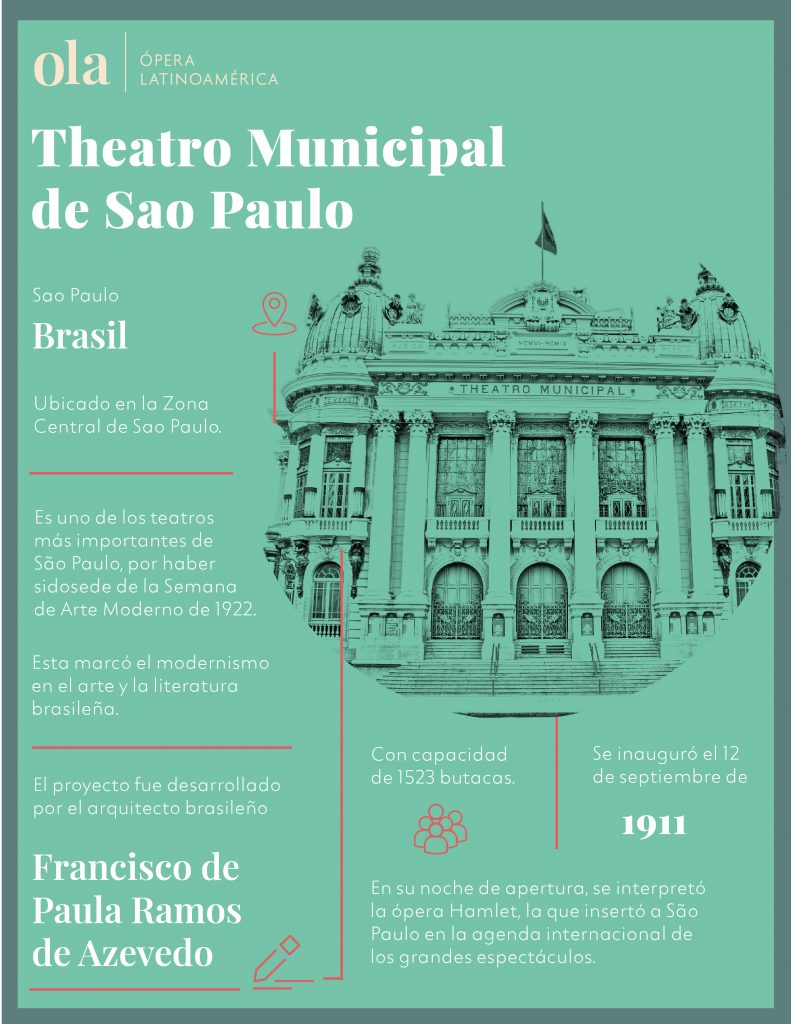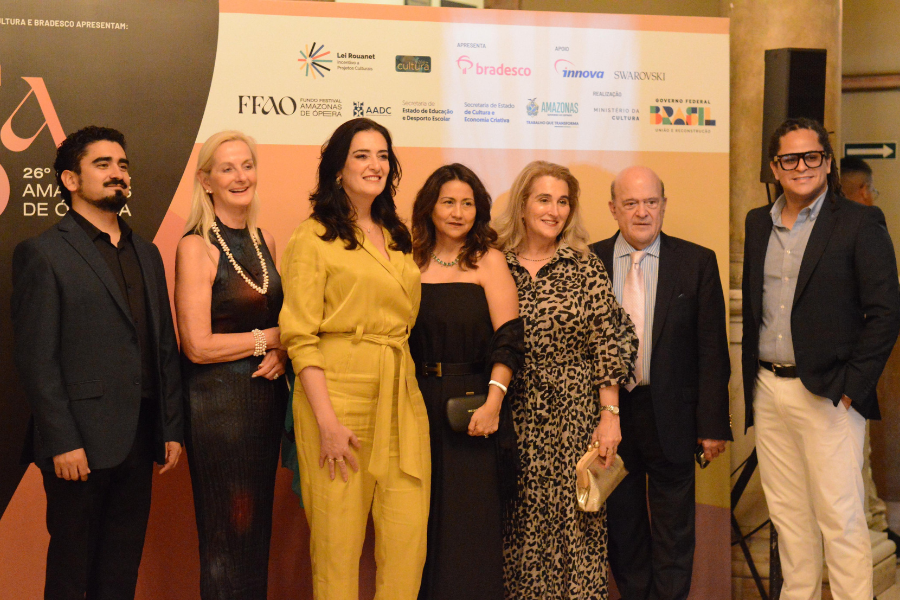Theatro Municipal de São Paulo, un lujo histórico
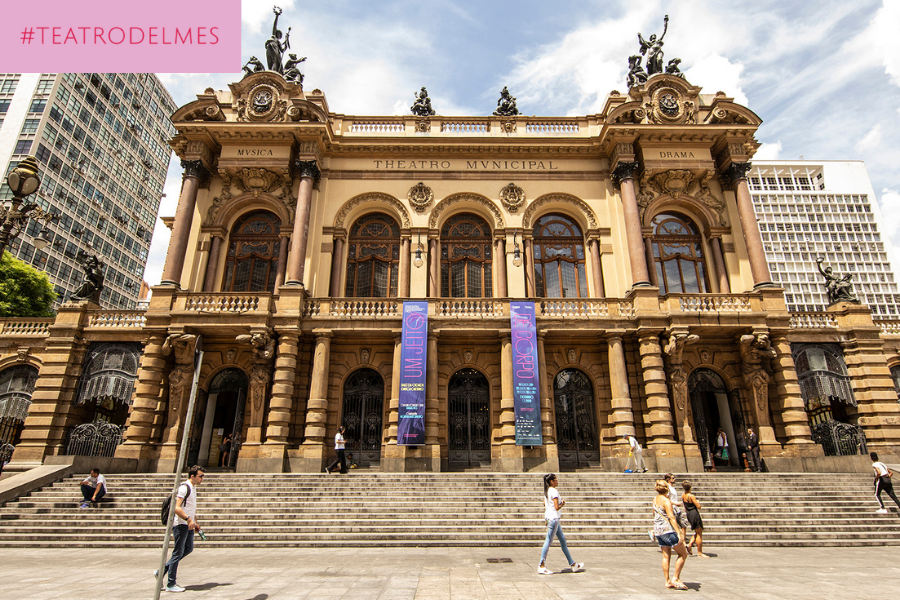
Continuamos con nuestra nueva sección «Teatro del Mes», en la que destacamos la historia y el valor arquitectónico de los teatros que conforman nuestra red. En esta edición, te presentamos el Theatro Municipal de São Paulo.
Fundado el 12 de septiembre de 1911, el Theatro Municipal de São Paulo se erige en el centro de la ciudad, entre el bullicio y la vida cosmopolita de la capital paulista. En 1922, el complejo fue sede de la icónica “Semana de 22”, un evento que encendió la mecha para el movimiento de los modernistas brasileños. Hoy, el complejo alberga, entre otros cuerpos artísticos, a la Orquesta Sinfónica Municipal de São Paulo y al Ballet de la Ciudad de São Paulo, además de contar con un sólido proyecto pedagógico y de formación artística. Con una arquitectura que entrelaza los estilos renacentista, barroco y art nouveau, este teatro es un patrimonio nacional de Brasil que relata la exuberante y turbulenta historia cultural de São Paulo.
Por Álvaro Molina R.
En 1912, el poeta brasileño Oswald de Andrade regresó de Europa a su natal São Paulo. Recién había terminado una breve gira por países como Francia, Italia, Alemania e Inglaterra, donde se empapó de las ambiciones que las vanguardias europeas estaban esparciendo como un nuevo soplo artístico por el continente. Al observar los conflictos y el tumulto que se había armado entre los incipientes modernistas brasileños y el conservadurismo nacionalista del país, declaró, con la manifiesta influencia del futurismo de Marinetti: “estamos cincuenta años atrás en cultura, revolcándonos todavía en pleno parnasianismo”.
Diez años después, Oswald de Andrade y Mário de Andrade (sin relación a pesar de compartir apellido) se encargaron de producir y promocionar la Semana de Arte Moderno en São Paulo. El emblemático festival de arte tuvo como sede al Theatro Municipal de São Paulo, que cumplía su primera década de existencia como eje central de la actividad cultural paulista. Sin embargo, la “Semana de 22” no estuvo exenta de polémicas. Los artistas fueron abucheados y bombardeados por ciertos grupos conservadores de las artes, que veían con recelo la radicalización artística que el movimiento proponía. Escritores ligados a la Academia Brasileña de Letras o de corte nacionalista, como José Monteiro Lobato, atacaron y condenaron rotundamente el festival.
A pesar de los conflictos entre la naciente vanguardia y el establishment brasileño, la Semana de Arte Moderno significó una renovación en el lenguaje y las artes de Brasil. Reflejó, también, la vocación cosmopolita de una ciudad que con el tiempo se convirtió en un punto neurálgico de la cultura en Latinoamérica. Y la piedra angular de ese espíritu y energía artística paulista fue el Theatro Municipal de São Paulo.
Historia
A inicios del siglo XX, Brasil todavía se encontraba en los primeros años de su formación como república luego del abrupto fin del imperio. São Paulo, hasta ese entonces, era un importante centro de exportación de café y su economía era un insumo vital para el desarrollo del país. Los terratenientes y la aristocracia paulista, reacios en un principio a los procesos de industrialización, buscaron mantener su influencia en la cultura y estética de la ciudad.
Alrededor de 1903, la élite demandó la construcción de un edificio para las artes que cumpliera con los estándares internacionales y estuviera a la altura de los grandes teatros europeos. Luego del incendio que inhabilitó para siempre al antiguo Theatro São José, la ciudad necesitaba un nuevo escenario para albergar las grandes producciones de ópera y espectáculos del mundo. La misión fue encargada a la oficina del ingeniero Francisco de Paula Ramos de Azevedo, quien, con ayuda de los arquitectos italianos Claudio y Domiziano Rossi, dio forma a un espectacular e inédito edificio cuya opulencia renacentista y barroca brillaba en la llamada Morro do Chá o “Colina del Té” de São Paulo.
La obra era un espectáculo a la vista. Ramos de Azevedo tomó como referencia al Palais Garnier de París para darle forma al nuevo coliseo paulista que, en los años siguientes, recibió las producciones de ópera que Europa exportaba a Latinoamérica.
En 1911, ocho años después de su construcción, el Theatro Municipal de São Paulo por fin abrió sus puertas al público. El 12 de septiembre, las personalidades más destacadas de la sociedad paulista se congregaron para la inauguración del teatro. La función de apertura fue una presentación de la grand opera francesa Hamlet, del compositor Ambroise Thomas, con una espectacular puesta en escena. No obstante, la crítica paulista no estaba del todo contenta. Los resquicios nacionalistas que trascendieron al fin del imperio brasileño se hicieron presentes y los especialistas y críticos exigieron que el programa también incluyera una obra nacional.
Hasta ese entonces, el compositor con más renombre de Brasil era Carlos Gomes (1836 – 1896). Y no era solo casualidad; fue el primer compositor latinoamericano cuyas obras se aceptaron en Europa. Su trabajo más famoso, la ópera El guaraní, se estrenó en La Scala de Milán en 1870 y de ahí en adelante Gomes se convirtió en un referente de la música brasileña.
Con la intención de dotar la inauguración del Theatro Municipal de São Paulo con un componente patriótico, la obertura de El guaraní fue la pieza que abrió el programa la noche del 12 de septiembre de 1911 para luego continuar con el Hamlet de Thomas. La función fue todo un éxito. La clase dirigente de la ciudad se sorprendió y las expectativas – que ya eran altas – se superaron con creces. Al fin había llegado a la ciudad un teatro que cumplía con las ambiciones cosmopolitas de la sociedad paulista.
En sus primeros 14 años, el Theatro Municipal de São Paulo presentó 88 óperas de 41 compositores de origen nacional e internacional. Hasta 1926, el teatro había organizado alrededor de 270 funciones sobre su escenario y ya se imponía en la escena lírica latinoamericana e internacional.
A mediados del siglo XX, el desarrollo industrial de São Paulo hacía presencia en la arquitectura de la ciudad. Nuevos y modernos edificios eran el vivo ejemplo del desarrollo de una ciudad que ebullía y paulatinamente se fue convirtiendo en una de las megalópolis más emblemáticas de América Latina. El crecimiento urbano comenzó a contrastar con el legado renacentista, barroco y art nouveau del Theatro Municipal de São Paulo, perdiendo parte de su característica opulencia en medio de rascacielos como, por ejemplo, el edificio Altino Arantes, el “Empire State” de São Paulo.
El teatro se encontró de frente con el progreso. Durante la década de 1950, el alcalde Jânio Quadros encargó la primera gran remodelación del edificio para sacarle lustre en el marco del Cuarto Centenario de la ciudad de São Paulo. Pero las transformaciones sociales y culturales en la sociedad brasileña fueron relegando al Theatro Municipal a un lugar simbólico, cuyo valor en la sociedad paulista quedó en ser un símbolo patrimonial más que un espacio articulador de la comunidad como lo fue en sus inicios.
Los más grandes rostros, cuerpos y voces del siglo XX pasaron por el escenario del Theatro Municipal de São Paulo. Nombres como los de Enrico Caruso, Maria Callas, Bidu Sayão, Arturo Toscanini, Carmargo Guarnieri, Heitor Villa-Lobos, Francisco Mignone, Ana Pawlova, Arthur Rubinstein, Claudio Arrau, Duke Ellington, Ella Fitzgerald, Isadora Duncan, Vaslav Nijinsky y Mikhail Baryshnikov marcaron pasaporte en el teatro y demostraron que el lugar era un centro gravitante en el panorama cultural internacional, incursionando no solo en la ópera, sino también en el ballet y jazz de la tercera corriente.
Hoy en día, el Theatro Municipal de São Paulo es un emblema y punto de referencia de la capital paulista. El complejo alberga a grupos artísticos como la Orquesta Sinfónica Municipal de São Paulo, la Orquesta Experimental de Repertorio, el Cuarteto de la Ciudad de São Paulo, el Coro Lírico y Coral Paulistano y el Ballet de la Ciudad de São Paulo.
La confluencia de estos diferentes cuerpos de artes han convertido al teatro en un lugar de orgullo histórico, que ha abierto sus puertas a todo tipo de públicos con espectáculos gratuitos y permanentes actividades culturales.
Aunque la historia de este teatro se encuentra atravesada por episodios de agitación cultural y social, su valor patrimonial se mantiene vivo e inmanente en el imaginario colectivo de São Paulo.
Ambientes, espacios y sectores
La infraestructura del Theatro Municipal de São Paulo se erige prácticamente como un mosaico de materiales que vienen de todas partes del mundo. Cuando entramos al edificio, nos encontramos de plano con el salón principal. Nos recibe una imponente escalera de mármol italiano que está ahí desde la inauguración del teatro. Instalar la escalera fue tan duro como el material mismo; venía completamente desmontado y sus partes tenían que ensamblarse manualmente, como un enorme rompecabezas.
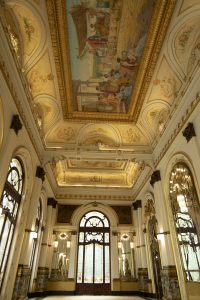
El Salón Noble destaca por su exuberante y lujosa ambientación, otrora sede de las fiestas, los bailes y las reuniones de la alta sociedad de São Paulo. Foto: Stig Lavor
En el segundo piso, las vidrieras de Alemania y los espejos y cristales de Bélgica decoran el lujoso y ecléctico Salón Noble. Durante el siglo pasado, esta sala fue la principal sede para las fiestas organizadas por los barones del café. La suntuosidad del espacio se refuerza con pinturas de cupidos griegos (obras del pintor brasileño Oscar Pereira Silva) y tapices romanos que fueron la escenografía de fastuosas cenas y bailes de máscaras que reunieron a la alta sociedad de São Paulo en ese tiempo.
Las principales obras se presentan en la Sala de Espectáculos. El majestuoso escenario principal fue inspirado en el modelo de teatros “a la italiana” para que el sonido llene todos los rincones de la sala. Al momento de su diseño, el Theatro São Paulo se concibió con la idea de recibir las grandes producciones de ópera europeas que dominaban la agenda de esa época. Con esto en cuenta, el escenario tiene una profundidad de hasta 20 metros, con una capacidad de tres a cuatro escenarios por sesión.
Como una forma de hacerse partícipe de la educación cultural en São Paulo, el teatro amplió su labor formativa al inaugurar en 2012 la Praça das Artes. Hace algunos años, el teatro definió un proyecto educativo con la intención de generar oportunidades para jóvenes que buscan desarrollarse profesionalmente en la escena lírica, musical y de danza, el complejo también es sede de la Escuela Municipal de Música de São Paulo y la Escuela de Danza de São Paulo. El Theatro Municipal promueve la integración de sus diferentes cuerpos artísticos a través de trabajos intersectoriales como la participación en producciones, ensayos y masterclasses, aprovechando el encanto que posibilita la Praça das Artes como foco de encuentro cultural, social y urbano.
Hoy, con más de 100 años de historia, el Theatro Municipal no solo es la insignia cultural de São Paulo. Pronto a celebrar su aniversario número 110, este complejo continúa siendo un punto de encuentro vital para acercar las artes y la escena lírica a los más de 12 millones de habitantes de esta ciudad.


